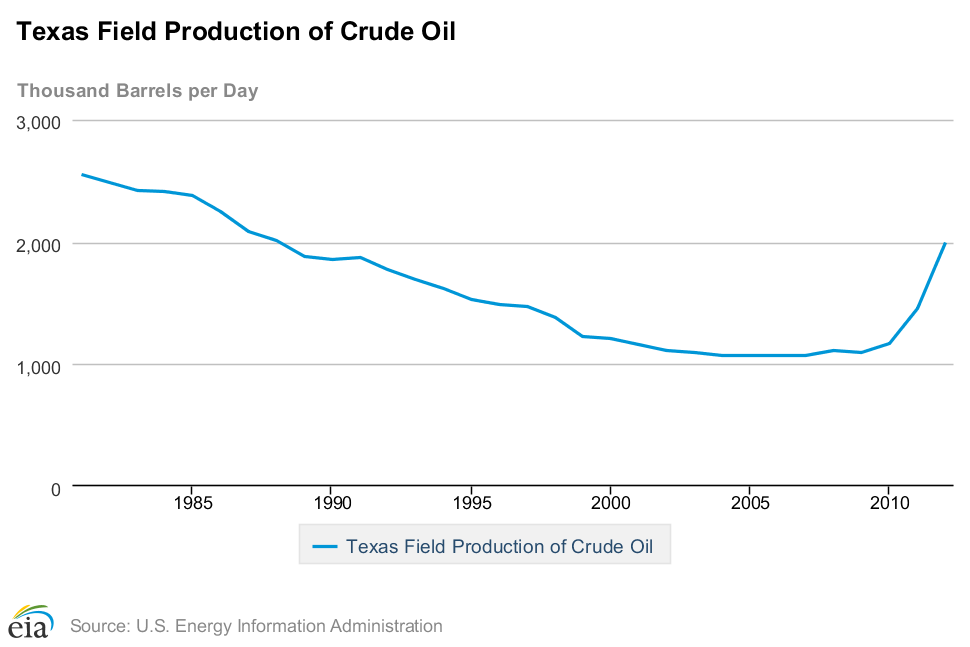Texas has been known for decades as the oil state, accompanied by the quintessential stereotype of oilman as a big, loud buffoon, wearing boots and a 10-gallon hat with oil wells in his backyard. Embarrassingly, that stereotype has been perpetuated over the years by the antics of some of our politicians and public figures, but has really never been true.
Historically, Texas has been a progressive and forward-thinking state, leading in engineering, new technologies, and especially in the innovations in the hydrocarbons extraction business that have been developed by companies based in Texas. The results of those innovations, as well as the presence of easily obtainable conventional oil production, made Texas an energy powerhouse in the early to mid 20th century. However, after peaking in the early 1970s at about 3 1/2 million barrels of oil per day, production in Texas declined steadily for the next almost 40 years. Texas' dominance faded, as did revenues from oil production in the state.
Production continued to decline until about 10 years ago when the industry began refining new technologies that allowed access to reservoir rock that had been previously unproductive. The industry had been drilling directional holes for years offshore in order to have access to a number of wells from one platform; that same technology was then moved onshore to drill controlled holes to subsurface targets. With the advent of better control of the drillbit, as well as the development of tools to evaluate formations in real time while drilling, horizontal wells began becoming more and more common to access more drainage area from rock that had previously been unproductive. Multiple hydraulic fracturing treatments were then developed, and the shale boom began. Much of the early shale drilling occurred in Texas, but then spread to northern and northeastern states, where vast resources of entrapped oil and gas could finally be accessed. In Texas, shale drilling began in earnest about seven years ago reversing the decades-long decline in oil production.

Texas is now home to 47 percent of all rigs drilling in the U.S. drilling primarily in West and South Texas, and produces 30 percent of U.S. production. All of this is possible with the new technologies, but this success is not without controversy. As hydraulic fracturing has become more common, the public's awareness has also increased. There is a lot of concern, as well as hysteria and hyperbole, surrounding hydraulic fracturing, but there are clear issues with which the industry continues to grapple. The primary issue is the destruction of millions of barrels of fresh water, and the other is (though likely rare) the contamination of ground water. The industry has historically dismissed these concerns publicly, while knowing that some of these are legitimate. There are many claimed cases of ground water contamination; however, I believe that the vast majority of contamination that does occur likely comes from careless handling of flowback and produced water at the surface, or even other sources, allowing contaminated water to percolate down to fresh water sands, not necessarily coming from below as a consequence of the frac jobs themselves. The industry has begun sophisticated analysis to determine the possible sources of groundwater contamination.
My biggest concern is the use of fresh water in completion operations, including hydraulic fracturing. Intensive operations (along with long-lasting drought) are reducing water tables to dangerously low levels in West and South Texas, risking water supplies for domestic use. In areas of drought or low water availability, this water use is unsustainable, in my view, and the industry must develop more reliable methods of recovery and re-use, as well as continuing the development of new techniques that don't use water at all.
Hydraulic fracturing is clearly with us to stay... around 90 percent of wells drilled in the U.S. would be unproductive without it, and our own domestic production is simply too important to our energy security to not use it. Having said that, though, we must continue to advance the technology to improve safety and reduce the risks of developing this vital resource.
